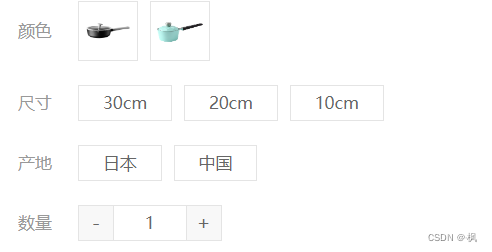
首先看一下我们拿到的数据sku数据和商品数据先实现
//商品数据
specs:
[{
name: "颜色",
values:[{name: "黑色"},{,name: "蓝色",}]
},
{
name:"尺寸"
values:[{name: "黑色"},{name: "蓝色"}]
},
{
name:"产地"
values:[{name: "中国"},{name: "日本"}]
}]
//对应的sku
skus = [
{
inventory: 999965,//库存
oldPrice: "200.00",//原价
picture:
price: "166.00",//优惠价
skuCode: "guo-100001",
spuce: [
{ name: "颜色", valueName: "黑色" },
{ name: "尺寸", valueName: "20cm" },
{ name: "产地", valueName: "中国" },
],
},
];好的,现在拿到了数据我们可以先把今天效果实现,先实现静态后面相对比较容易理解
<template>
<div class="goods-sku">
<dl v-for="item in goods.specs" :key="item.id">
<dt>{
{ item.name }}</dt>
<dd>
<template v-for="val in item.values" :key="val.name">
<img
:class="{ selected: val.selected, disabled: val.disabled }"
@click="clickSpecs(item, val)"
v-if="val.picture"
:src="val.picture"
:title="val.name"
/>
<span
:class="{ selected: val.selected, disabled: val.disabled }"
@click="clickSpecs(item, val)"
v-else
>{
{ val.name }}</span
>
</template>
</dd>
</dl>
</div>
</template>
//css
<style scoped lang="less">
.sku-state-mixin () {
border: 1px solid #e4e4e4;
margin-right: 10px;
cursor: pointer;
&.selected {
border-color: @CjColor;
}
&.disabled {
opacity: 0.6;
border-style: dashed;
cursor: not-allowed;
}
}
.goods-sku {
padding-left: 10px;
padding-top: 20px;
dl {
display: flex;
padding-bottom: 20px;
align-items: center;
dt {
width: 50px;
color: #999;
}
dd {
flex: 1;
color: #666;
> img {
width: 50px;
height: 50px;
.sku-state-mixin ();
}
> span {
display: inline-block;
height: 30px;
line-height: 28px;
padding: 0 20px;
.sku-state-mixin ();
}
}
}
}
</style>
好的,接下来我们可以一步步的走逻辑,首先的话肯定是要先拿到所有sku的路径字典,拿到路径字典来判断选择项目是否可以进行选择
/**
* Find power-set of a set using BITWISE approach.
*
* @param {*[]} originalSet
* @return {*[][]}
*/
export default function bwPowerSet(originalSet) {
const subSets = [];
const numberOfCombinations = 2 ** originalSet.length;
for (
let combinationIndex = 0;
combinationIndex < numberOfCombinations;
combinationIndex += 1
) {
const subSet = [];
for (
let setElementIndex = 0;
setElementIndex < originalSet.length;
setElementIndex += 1
) {
if (combinationIndex & (1 << setElementIndex)) {
subSet.push(originalSet[setElementIndex]);
}
}
subSets.push(subSet);
}
return subSets;
}
这个是幂集算法根据这个可以拿到所需要的sku路径字典
接下啦我们使用这个方法拿到所有有库存的sku路径,用特殊字符串拼接每一项
// 拿到路径字典
const pathMap = getPathMap(props.goods.skus);
const spliter = "★"; //特殊符号可以自己随便定义
// 根据skus数据得到路径字典对象
const getPathMap = (skus) => {
const pathMap = {};
// 对skus数组进行遍历
skus.forEach((sku) => {
// 1. 过滤出有库存有效的sku
if (sku.inventory) {
// 2. 得到sku属性值数组(sku的name,(例如黑色,30,中国))
const specs = sku.specs.map((spec) => spec.valueName);
// 3. 得到sku属性值数组的子集 (这个函数就是上面写的幂集算法)
const powerSet = getPowerSet(specs);
// 4. 设置给路径字典对象
powerSet.forEach((set) => {
const key = set.join(spliter);
// 我们用得到的路径来当对象的key
if (pathMap[key]) {
// 已经有key往数组追加(因为黑色,20厘米,肯定不止一个,中国有,日本也有,所有如果key存在那么就往数组内添加他的id)
pathMap[key].push(sku.id);
} else {
// 没有key设置一个数组
pathMap[key] = [sku.id];
}
});
}
});
return pathMap;
//现在我们就得到了路径字典
};*我直接再代码里用注释讲解每一次,更容易理解*
太长了分两篇讲解,下篇地址